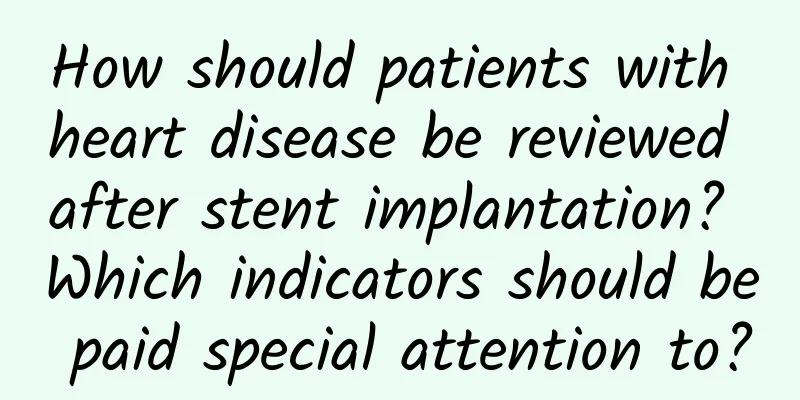How should patients with heart disease be reviewed after stent implantation? Which indicators should be paid special attention to?

|
After a heart stent is implanted, the biggest fear is side effects. How to detect the side effects of the stent in a timely manner and regular checkups are the key . But you will find that every time you go to the hospital for a follow-up checkup, the doctor prescribes a variety of tests, which vary greatly from patient to patient. Some require blood draws, some ultrasounds, and some even require follow-up angiography! How should you follow up after a heart disease stent? What indicators should you focus on? Let's take a look: 1. Blood test Routine blood test: Long-term use of antiplatelet drugs after stenting may cause gastrointestinal bleeding, which is also one of the most common side effects. Regularly reviewing routine blood tests and monitoring whether there is an abnormal decrease in hemoglobin can promptly detect the possibility of gastrointestinal bleeding. For patients with gastric diseases, it is also very important to observe whether there is black stool, bloody stool, and monitor fecal occult blood . Liver and kidney function: Oral heart disease medications are almost all metabolized by the liver and kidneys. If you take a lot of medications for a long time, if the burden on the liver and kidneys is exceeded, it may cause liver and kidney dysfunction, or even liver and kidney failure, especially in the elderly, low-weight patients, and patients with underlying liver and kidney diseases. Therefore, it is necessary to regularly check liver and kidney function, and adjust medication treatment in a timely manner if abnormalities are found. In addition, after stent surgery, blood lipids and blood sugar should be strictly controlled to reduce the risk of recurrence of heart disease. 2. Large-scale inspection Cardiac ultrasound: For patients with acute myocardial infarction and heart failure, regular cardiac ultrasound examinations can assess the extent of heart damage and changes in heart function. Chest CT: When heart disease needs to be differentiated from lung disease, such as pneumonia, pleural effusion, and chronic obstructive pulmonary disease, chest CT can assist in diagnosis. However, ultrasound and CT are not routine review items, and doctors will conduct examinations based on the patient's condition. 3. Cardiac angiography There is no strict requirement for annual cardiac angiography after stenting, but it is recommended if the patient falls into the following situations: Those who have recurrence of symptoms after stenting, those with untreated critical lesions who choose conservative drug treatment, those who receive new technology treatments such as drug-eluting balloons or absorbable stents, etc. IV. Other special inspections Myocardial radionuclide examination: It is used to evaluate the degree of myocardial ischemia and survival, especially occlusive lesions. It has certain guiding significance in guiding doctors whether to perform stent surgery to open blood vessels, but it is not a routine examination. I am Dr. Zhang from the Department of Cardiology. If you like my popular science articles, please like them! You can also share them with friends in need! Follow me to see more health knowledge about heart disease! |
<<: Night Listening|Is it OK to skip breakfast?
>>: Tumor markers elevated? Don’t panic! Here’s the truth!
Recommend
What are the reasons for early menstruation?
Menstruation is a physiological characteristic of...
What are the conditions for a normal birth?
Nowadays, many women are beginning to worry about...
How can a miscarriage occur in early pregnancy?
Pregnancy is a very happy thing for women, becaus...
Are sprouted potatoes poisonous? Eating these 9 foods incorrectly can cause "poisoning", so be careful when eating them!
Recently, the news #Girl fainted and was sent to ...
Science in Action: The Best Strategy for Preventing Knee Osteoarthritis
Author: Niu Guangming: The First Affiliated Hospi...
Can women eat soybeans every day?
Soybean, also known as yellow soybean, is the see...
What to do if the eyelash curler doesn’t curl?
If your eyelash curler doesn't curl, you can ...
How long does it usually take for the first baby to be born?
Spotting during pregnancy is a key sign of labor....
Can I eat lemon during menstruation?
I have become very fat recently, so I have been l...
Why do I urinate more when my period is coming?
Menstruation is a very important physiological ph...
How to protect the cervix
Gynecological diseases are very scary for women. ...
What foods are good for hair loss during breastfeeding?
Women who are breastfeeding may also experience s...
What causes abdominal pain in pregnant women?
Many pregnant women will have such problems, that...
What breast examinations should be done?
Maintaining good health is very important. In add...









